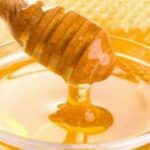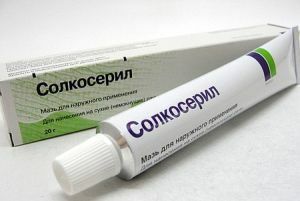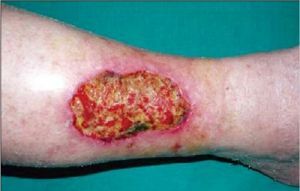 Speaking of trophic ulcers, it is important to emphasize that this is not so much a separate disease, but damage, caused by the long absence of regeneration of , as a result of disruption of the supply of the skin area with blood and tissue rejection. Ulcers can show themselves in various parts of the body, depending on the diagnosis.
Speaking of trophic ulcers, it is important to emphasize that this is not so much a separate disease, but damage, caused by the long absence of regeneration of , as a result of disruption of the supply of the skin area with blood and tissue rejection. Ulcers can show themselves in various parts of the body, depending on the diagnosis.
This type of ulcer is distinguished by the duration of healing( longer than 1-2 months) with regular periods of exacerbation.
Trophic ulcers are formed mainly on the lower limbs( often in the area of the ankles), but can also appear on other skin areas, and even on mucous membranes.
Trophic ulcers in varicose veins are skin defects, which for a long time do not lend themselves to the healing of , developing on the background of blood stagnation in varicose venous disease.
The danger of them is sufficiently substantiated, because this kind of damage on the legs was noticed in 15% of people suffering from VR veins. The appearance of these ulcers is associated with that stage of development of varicose veins, when the valves of the subcutaneous and deep veins are completely destroyed.
You can permanently remove this ulcer with a laser.
Treatment of skin lesions should be combined with the elimination of varicose veins. Specially developed medical dressings and ointments contribute to the disappearance of ulcers only in the case of varicose syndrome.
Ulcers with varicose veins are relatively well treated. The more severe case - the ulcer in the case of postthrombosis is more difficult to eliminate, but it is possible.
 What other folk ways to treat trophic ulcers exist and which ones worth choosing in our article.
What other folk ways to treat trophic ulcers exist and which ones worth choosing in our article. Want to know what is better Venarus or Detralex for varicose veins? Then you will be interested in the article by reference.
Venous congestion, formed by the discharge of blood from the deep veins into the superficial - the main cause of this manifestation of VRV venous trophic ulcer.
Stagnant blood, saturated with toxins, causes changes in its color with the formation of ulcers. For ulcers conjugated to the VR veins, the most common location is on the ankles and lower leg. Without serious medical intervention, even the epithelial ulcer can recur.
Contents of
- Causes of
- disease Causes of
- as a trophic ulcer
- Necessity of ointments for treatment of
- Stages of trophic ulcer
- What is characteristic of each stage of trophic ulcer
- The first phase of
- The second phase of
- The third phase of
- The fourth stage of
- Video: Modern methods of treatment of venous trophic ulcers
Causesthe appearance of
In most cases, the causes are such diseases, as:
- venous insufficiency( thrombophlebitis in the background of varicose veins);
- sharp narrowing of the arteries lumen due to atherosclerosis, diabetes mellitus, hypertension;
- violation of lymphatic drainage( elephantiasis);
- infringement of a innervation of fabrics( at a trauma, some diseases);
- on the background of chronic skin diseases and injuries.
The circumstances of the occurrence of ulcers are large, and the results of diagnosis should be taken into account, because the subsequent treatment depends on this.
Against the backdrop of diseases such as varicose veins, heart failure, diabetes, obesity, minor disruption of the integrity of the skin can lead to chronic trophic ulcers.
How the trophic ulcer

proceeds. Stages of trophic ulcer development
Trophic ulcers occur for a long time, which completely exhausts the patient.
Rarely, the trophic ulcer appears unexpectedly, preceded by such manifestations as pain, swelling, heaviness, a little later there are prolonged itching and burning, and convulsions may also occur at night.
After a while, the skin becomes purplish or purple, becoming rough when palpated and the pains the .As a result of venous stagnation of blood , trophic tissue ( ability to obtain nutrients and oxygen) deteriorates. Tissue decay products accumulate, because tissues that do not receive nutrition die
Need for ointments in the treatment of
The healing of ulcers begins after it is cleared, acquires a red color and bleeds when it palpates. Use of ointments, and gel bandages is used.
Number of dressings - about once a day, and flushing is not so necessary.
For , the improvement in the outflow of blood , at night the injured leg is lifted by 20 degrees, and in the daytime - by compression. With trophic ulcers, along with the treatment of the main diagnosis, local therapy and physiotherapeutic procedures with anti-inflammatory and bactericidal measures are effectively performed.
sclerotherapy is widely used, sometimes one-stage plastic is used when the skin area is superimposed on the cleared ulcer surface. In difficult cases rescues amputation, which preserves the viability of the person and the function of the limb, prosthetics is performed.
The best treatment tactic involves conservative measures in conjunction with surgical intervention. Against secondary infection requires ointments, which include antibiotics.
Trophic ulcer stages
Trophic ulcer in the case of VRV has the following four phases of development:
- appearance and progression;
- cleansing trophic ulcer;
- granulation in the center of the ulcer and scarring along the edges;
- granulation and cicatrization of the ulcer.
What is typical for each stage of the trophic ulcer
The first phase of
In the first phase occurs appearance of "lacquer" skin with redness, determined by high puffiness of the skin. Then begins to drop out liquid drops, and pale spots are formed - dead skin.
The phase can last from hours to weeks, depending on the stage of BP, treatment and prevention.
Typical symptoms in the 1st phase are: pain, difficulty of movement, high fever. Apply cleansing, disinfectant and improves nutrition of ointment for the treatment of trophic ulcers.
 Recommended ointments for trophic ulcers, like Solcoseryl and Actovegin , in different forms: first use 20% gel( 1-4 days), after - 5% cream( 4-11 days), then - 5% ointment. No less effective and ointment Algofin , containing antibacterial agents of a wide spectrum of action - derivatives of chlorophyll. Antimicrobial and healing effect is provided by Levosin and Levomekol.
Recommended ointments for trophic ulcers, like Solcoseryl and Actovegin , in different forms: first use 20% gel( 1-4 days), after - 5% cream( 4-11 days), then - 5% ointment. No less effective and ointment Algofin , containing antibacterial agents of a wide spectrum of action - derivatives of chlorophyll. Antimicrobial and healing effect is provided by Levosin and Levomekol.
The second phase of
In the second phase of development, as well as at the end of the first, the kind and secret of the ulcer depends on the effectiveness of treatment and the attachment of infection. A typical trophic ulcer has rounded edges, as well as mucous, purulent, bloody and fibrinous discharge.
The central role is performed by cleaning the injury( up to 1.5 months).
Third phase

Ulcer before use of Betadine
After the third phase comes. In phase 2, as for the treatment, after granulation, Betadine, Wundehil, Metuluracil-D, Tiotriazolin, Etonia are used. Betadine , thanks to iodine in the composition, effectively eliminates fungi and viruses, promotes granulation. A phytopreparation ointment Vundehil , promotes tissue repair, eliminates necrosis and purulent formations, and Etonia also anesthetizes.
With regard to the third phase, its length in time depends on the size of the ulcer, the quality of local procedures and general treatment. Without active treatment, the scarring will not end, and everything will start again.

Ulcer after 10 days of use of Betadine
At this stage, epithelization of occurs - the appearance of "new" skin. In the 3rd stage of the wound process, wound healing ointments are applied with trophic ulcers with a pronounced ability to activate the recovery - Bepanten, Kuriyozin, Mefenat, Alantan Plus. Bepanten Ointment , containing panthenol, is also used for a variety of skin and mucous membrane lesions.
Fourth stage of
In the fourth stage, the ulcer decreases in size, its scarring is completed by .The fourth stage lasts until complete healing. In this period, recommended to receive 10% of the ointment, St. John's wort, Comfrey, Calendula and other ointments for the healing of trophic ulcers.
There are also folk ointment recipes for the treatment of trophic ulcers:
- Yellow ointment against trophic ulcers. With the help of such an ointment, even old ulcers are treated, proportions are important. Fresh chicken yolks with a teaspoon put into a container, and in a 1: 1 ratio, add 5% iodine solution. Stir the ointment until dark yellow. Store it in a dark place, at room temperature. Using a teaspoon ointment should be poured on the wound, making sure not to get on a healthy skin. Apply a clean napkin, bandage. Change once every 12 hours;
- Use of oily and vegetable ointment against trophic ulcers. This recipe is effective for diabetes. Ingredients: 1 onion, 1 carrot, ½ tbsp.unrefined sunflower oil. Peel the onion, finely chop, grate the grated carrot, add to the onion. Fry the mixture on low heat, using the entire volume of oil. The resulting mixture of golden color squeezed and applied to ulcers in the form of lotions. Repeat at least 3 times a day.
Trophic ulcer is an unpleasant, a little aesthetic phenomenon, dangerous due to its complications.
As for the treatment itself, ointments are the most affordable and effective aid, the plus of which is the variety of choice and ease of use. For all this it is important to remember that after the complete cure it is important to keep track of your lifestyle.
